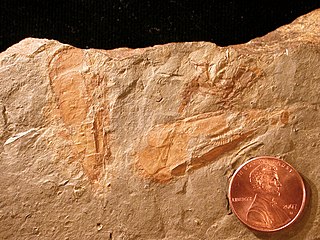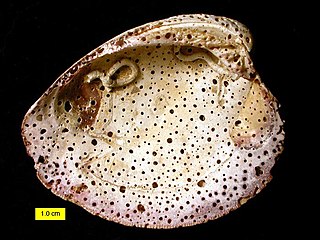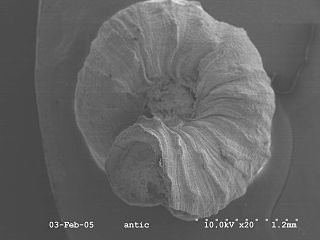
Hyoliths are animals with small conical shells, known as fossils from the Palaeozoic Era. They are lophophorates, a group which includes the brachiopods.

Tentaculites is an extinct genus of conical fossils of uncertain affinity, class Tentaculita, although it is not the only member of the class. It is known from Lower Ordovician to Upper Devonian deposits both as calcitic shells with a brachiopod-like microstructure and carbonaceous 'linings'. The "tentaculites" are also referred to as the styliolinids.

Bioerosion describes the breakdown of hard ocean substrates – and less often terrestrial substrates – by living organisms. Marine bioerosion can be caused by mollusks, polychaete worms, phoronids, sponges, crustaceans, echinoids, and fish; it can occur on coastlines, on coral reefs, and on ships; its mechanisms include biotic boring, drilling, rasping, and scraping. On dry land, bioerosion is typically performed by pioneer plants or plant-like organisms such as lichen, and mostly chemical or mechanical in nature.

Tabulata, commonly known as tabulate corals, are an order of extinct forms of coral. They are almost always colonial, forming colonies of individual hexagonal cells known as corallites defined by a skeleton of calcite, similar in appearance to a honeycomb. Adjacent cells are joined by small pores. Their distinguishing feature is their well-developed horizontal internal partitions (tabulae) within each cell, but reduced or absent vertical internal partitions. They are usually smaller than rugose corals, but vary considerably in shape, from flat to conical to spherical.

Spirorbis is a genus of very small polychaete worms, usually with a white coiled shell. Members of the genus live in the lower littoral and sublittoral zones of rocky shores. Spirorbis worms usually live attached to seaweeds, but some species live directly on rocks, shells or other hard substrates. Spirorbis was once thought to have a fossil record extending back into the Early Paleozoic, but now all pre-Cretaceous spirorbins are known to be microconchids. The earliest members of genus appeared in the Miocene, but Oligocene finds may also be possible. The genus contains the following species:

Stromatoporoidea is an extinct clade of sea sponges common in the fossil record from the Ordovician through the Devonian. They were especially abundant and important reef-formers in the Silurian and most of the Devonian. The group was previously thought to be related to the corals and placed in the phylum Cnidaria. They are now classified in the phylum Porifera, specifically the sclerosponges. There are numerous fossil forms with spherical, branching or encrusting skeletons of laminated calcite with vertical pillars between the laminae. Specimen of its oldest genus, Priscastroma, have been found within the Middle Ordovician Sediments. This same genus has been referred to as the species P. gemina Khrom., and is known to have been known to branch off into two forms, A and B. Form A gave rise to the genus Cystostroma while form B gave rise to the genus Labechia and its descendants. Paleozoic stromatoporoids died out at the Hangenberg Event at the end of the Devonian. Purported Mesozoic stromatoporoids may be unrelated, thus making "stromatoporoids" a polyphyletic group if they are included.

Carbonate hardgrounds are surfaces of synsedimentarily cemented carbonate layers that have been exposed on the seafloor. A hardground is essentially, then, a lithified seafloor. Ancient hardgrounds are found in limestone sequences and distinguished from later-lithified sediments by evidence of exposure to normal marine waters. This evidence can consist of encrusting marine organisms, borings of organisms produced through bioerosion, early marine calcite cements, or extensive surfaces mineralized by iron oxides or calcium phosphates. Modern hardgrounds are usually detected by sounding in shallow water or through remote sensing techniques like side-scan radar.

Cornulitida is an extinct order of encrusting animals from class Tentaculita, which were common around the globe in the Ordovician to Devonian oceans, and survived until the Carboniferous.

Sphenothallus is a problematic extinct genus lately attributed to the conulariids. It was widespread in shallow marine environments during the Paleozoic.

Tentaculita is an extinct class of uncertain placement ranging from the Early Ordovician to the Middle Jurassic. They were suspension feeders with a near worldwide distribution. For a more thorough discussion, see Tentaculites.
Trypanoporida is an extinct order of encrusting animals within Class Tentaculita, which were common in Devonian oceans. Their affinity is unknown; they have been placed among worms and corals. They appear to be closely related to other taxa of uncertain affinity, including the microconchids, cornulitids, and tentaculitids. Spirally coiled trypanoporids (Devonian) were most likely derived from the geologically older microconchids.

Anticalyptraea is a fossil genus of encrusting tentaculitoid tubeworms from the Silurian to Devonian of Europe and North America . Anticalyptraea commonly encrust various invertebrate fossils such as stromatoporoids, rugose corals, bryozoans, brachiopods and crinoids, but they can also be common on the hardgrounds. They were often attacked by predators in the Pridoli of Baltica.

Cornulites is a genus of cornulitid tubeworms. Their shells have vesicular wall structure, and are both externally and internally annulated. They usually occur as encrusters on various shelly fossils. Their fossils are known from the Middle Ordovician to the Carboniferous.

Conchicolites is a fossil genus of cornulitid tubeworms. Their shells lack vesicular wall structure and have a smooth lumen. They are externally covered with transverse ridges. Some species have spines. They usually occur as encrusters on various shelly fossils. Their fossils are known from the Late Ordovician to the Devonian.

Coralloconchus is a genus of cornulitid tubeworms with small, slender, irregularly curved conical tubes with slowly increasing diameter. Tubes have thin walls and a smooth lumen. Tube wall has a lamellar microstructure. Tubes are devoid of septa and vesicles in the adult part and are not spirally coiled.

Punctaconchus is a genus of microconchid tubeworms. It was the last genus of microconchids, and the only genus to exist beyond the Triassic. Their tubes have large pores (punctae) penetrating the tube wall. Tubes lumen is covered by ripplemark−like transverse ridges. Punctaconchus occurs in the Middle Jurassic of England, France and Poland.

Palaeoconchus is a genus of microconchid tubeworms. Their tubes have pseudopunctae penetrating the tube wall. Tubes lumen is smooth. Palaeoconchus occurs in the Late Ordovician of Baltica and Avalonia. In the Devonian it had a global distribution.

Annuliconchus is a genus of microconchid tubeworms. Their tubes have pseudopunctae penetrating the tube wall. Tubes lumen is annulated. Annuliconchus occurs in the Silurian of Baltica.
Tymbochoos is an extinct genus of encrusting tentaculitoid tubeworms. Tymbochoos has a laminar tube structure and pseudopuncta similar to those of the tentaculitoids. It has previously been interpreted as a Palaeozoic polychaete. The world's oldest build-ups with tube-supported frameworks belong to Tymbochoos sinclairi. They occur in the Ordovician limestones of the Ottawa Valley.
Olev Vinn is Estonian paleobiologist and paleontologist.

















